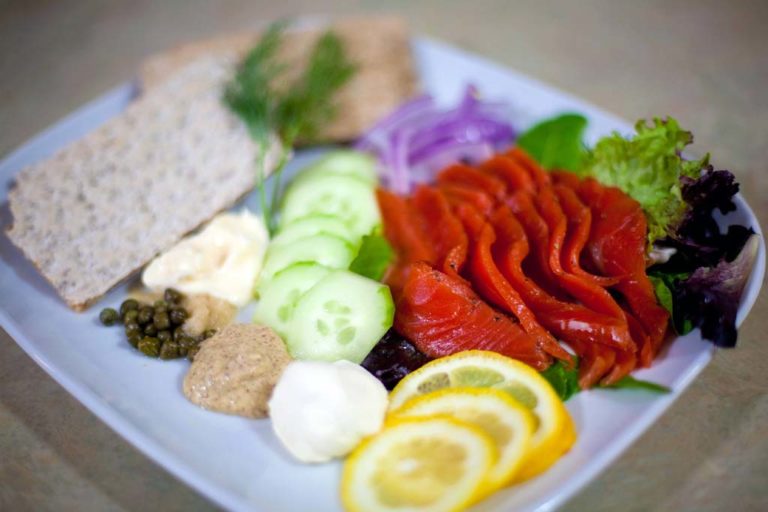
Chef's notes:
Gravlax is an old Nordic/Scandinavian method of curing salmon. It combines diffusion and fermentation to preserve the fish for use later. It was done by salting the fish and burying it in the sand above the tide line at the beach. The salt would diffuse into the interior of the cells, but not before the fish began to ferment or rot.
Nowadays you can make gravlax without fermentation by using just a salt/sugar cure. This is more than enough to preserve the fish.
For this recipe I used sockeye salmon, which is known for its relatively strong salmon flavor.
For those of you looking for a milder form of gravlax, try using farm-raised Atlantic salmon.
Ingredients
- 1 pound salmon fillet
- 4 Tbsp sea salt
- 3 Tbsp sugar
- 2 tsp black pepper
- 20 sprigs of dill
- 1 Tbsp vodka
Salmon Recipe: Sockeye Salmon Gravlax Cured with Sea Salt, Sugar, Black Pepper, Fresh Dill, and a Splash of Vodka
- Get the gravlax ingredients together. Up and to the right is the recipe for gravlax. It’s for one pound of fish. Just times it by however many pounds of salmon you have. Traditionally you make gravlax with a whole fish at a time. But you can use one fillet (as I have here) or even half a fillet.
- Remove the bones from the fillet. If the fillet still has pin bones in it, you will want to remove them using a pair of pliers. Just run your finger along the fillet until you feel a bone poking out. Then grab it with the pliers and give it a tug. It should come right out.
- Season the fillet. Lay the fillet on a large piece of plastic wrap or in a tray that is large enough to hold it. Drizzle the salmon with vodka or other booze. Then season the meat with the salt, sugar, and pepper. Top it with the dill and wrap it up.
- Wrap it up and refrigerate. Lay the fillet on the bottom of your refrigerator in a waterproof tray. Flip it over every 12 hours to move the juices around. The gravlax will take 3–4 days to fully cure. You may check it (and even taste it) if you wish.
- Unwrap and inspect the gravlax. Try a piece of the gravlax by slicing off a little sliver. If you are satisfied with the results, slice it up and eat it. If you are not satisfied, try and fix it. If that doesn’t work, you can always just cook the salmon. That should be interesting.
- Slice the gravlax thinly. If you plan on serving the salmon yourself, slice it up thinly. Otherwise, you can let your guests cut off their own pieces. I remove the skin first to avoid getting scales in my mouth—but that’s just a preference.
Tips & Tricks
- Cured gravlax is quite tasty, but it still tastes very much like salmon. So if you don’t really like salmon, you won’t really like gravlax.
- Gravlax also has a similar consistency to that of raw salmon. If you can’t stomach that texture, you won’t like gravlax.
- Gravlax is very good served with mustard, capers, dill, horseradish, lemon, and even mayonnaise.
- Also try serving gravlax with a selection of those condiments and toppings on thin bread or flat bread. I like Wasa, Kavli, or even Finn Crisp.
